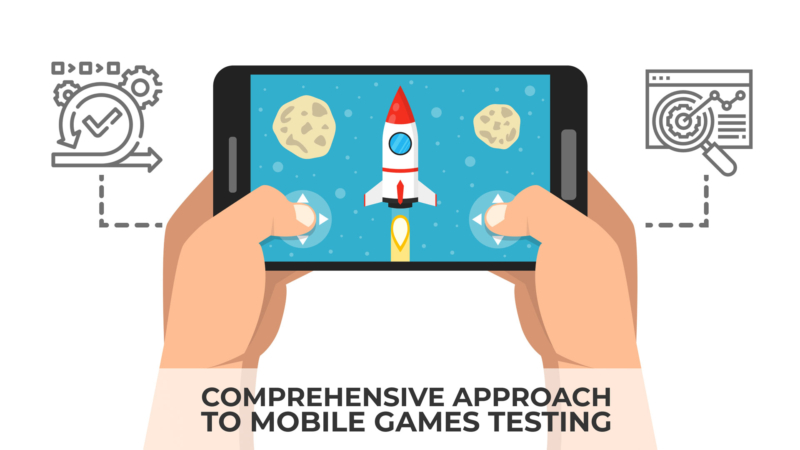Testing is an essential part of the custom game development life cycle. It involves the systematic quality evaluation of mobile and other types of games before they are released to the public.
Mobile game development testing, which we will cover in this article, enables us to identify and fix bugs, glitches, and other issues and deliver a smooth, enjoyable gaming experience to the user.
At Stepico, we perform a wide range of mobile game development testing types. This article focuses on five of them: function, performance, compatibility, usability, and security testing.
Types of Mobile Games Testing: Functional
In mobile game development, functional testing ensures that functionalities, controls, and in-game interactions align precisely with the design specifications. In simpler terms, it verifies that the features operate as intended. Functional testing comprises several phases.
Gameplay Testing
- Ensuring that game controls, such as touchscreen and buttons, respond correctly to user input. Examining all possible interactions within the game, including character movements, actions, and menu navigation.
- Testing the game’s core mechanics, including scoring, level progression, and character abilities, to ensure proper functionality.
- Assessing the accuracy of collision detection to confirm that objects interact with each other as expected. This step is critical for preventing glitches, such as characters passing through obstacles.
UI/UX Testing
- Checking if UI elements, such as buttons, menus, and the HUD, are displayed correctly on various devices and screen sizes.
- Testing the transitions between different screens and ensuring consistent positioning of UI elements.
- Assessing if the appearance of graphics, animations, and special effects aligns with the design specifications.
Level Design Testing
- Assessing the progression through various levels or stages to ensure players can advance through the game seamlessly.
- Evaluating the balance of difficulty across levels with the aim of creating a challenging yet enjoyable experience for players of varying skill levels.
Game Features Testing
- Testing whether special abilities, power-ups, or boosts activate correctly within the game and provide the intended effects.
- If the game includes multiplayer features, checking this functionality to ensure smooth online interactions, including matchmaking, connectivity, and synchronization.
- Verifying that in-app purchases, if present, are working correctly and that the associated transactions are processed securely.
Save and Load Functionality
- Ensuring that the game’s save and load features work as intended, giving the players an option to resume their progress without data losses.
Compatibility Testing
- Assessing whether the game runs consistently across various devices, operating systems, and screen resolutions and addressing any compatibility issues that may arise.
Error Handling and Recovery
- Testing how the game responds to unexpected situations, such as network interruptions, device resource limitations, or user errors.
- Ensuring that appropriate error messages are displayed and that the game can recover smoothly.
Localization Testing
- If the game supports multiple languages, verifying that translated texts fit within UI elements.
Cross-Platform Testing
- If the game is designed for multiple platforms (e.g., iOS and Android), assessing its performance on each platform separately to ensure consistent functionality.
Types of Mobile Games Testing: Performance
Performance testing involves assessing the responsiveness, stability, and efficiency of the title under various conditions. It also includes several subtypes.
Load Testing
- Evaluating the game’s performance when a large number of players are using it simultaneously.
- Identifying potential bottlenecks that are likely to hinder the game’s servers in terms of handling the expected player load.
Stress Testing
- Intentionally creating extreme conditions, such as high server load, low device resources, or poor network connection, to observe the game’s behavior and test if its recovery is fast enough.
Responsiveness Testing
- Checking the game’s responsiveness to user inputs.
- Ensuring minimal delay between a user action and the corresponding on-screen response.
- Measuring the frame rate and ensuring its consistency to prevent lags or stuttering during gameplay.
Scalability Testing
- Assessing thoroughly the title’s performance across a range of devices with varying hardware specifications to ensure it scales and runs well on different platforms.
- Evaluating how the game copes with increased network traffic, especially for multiplayer or online games.
Network Performance Testing
- Evaluating the bandwidth under different types of network connection, including 3G, 4G, and Wi-Fi.
- Testing the impact of network latency on the game’s flow, especially in multiplayer games where low latency is critical for real-time interactions.
Memory Usage Testing
- Identifying and addressing memory leaks that could lead to increased memory usage, potentially causing the game to slow down or crash.
- Optimizing the game’s code and assets to ensure efficient memory usage and prevent unnecessary strain on the device’s resources.
Profiling App Performance
- Analyzing CPU and GPU usage to identify bottlenecks and optimize resource utilization. We use CPU profiling tools to help identify code hotspots and threading issues and leverage GPU profiling tools that focus on shader performance, frame timing, and overall resource utilization.
Battery Consumption Testing
- Assessing the game’s resource-intensiveness and its effects on battery life on different devices.
- Identifying and addressing any features or processes contributing to excessive power consumption.
Duration and Longevity Testing
- Ensuring that the game remains stable and responsive during prolonged gameplay sessions.
- Verifying that the game efficiently manages resources over extended periods, avoiding performance degradation or crashes due to resource exhaustion.
Automated Performance Testing
- Utilizing automated performance testing tools to simulate various scenarios, monitor performance metrics, and identify bottlenecks in a systematic and repeatable manner.
Emulator and Real Device Testing
- Utilizing emulators to test device compatibility, operating system version, performance, network conditions, localization, and more. The emulators are integrated with automated testing frameworks for efficient and repeatable tests.
- Carrying out performance testing on real devices to get more accurate insights into how the game runs in a user’s hands.
Error Tracking and Logs Monitoring
- Identifying, capturing, and analyzing errors within the game, which involves implementing a logging framework, integrating specialized error tracking tools, and aggregating logs centrally.
- Proactively managing errors to streamline debugging processes and elevate the gaming experience.
Types of Mobile Games Testing: Compatibility
The goal of compatibility testing is to ensure the game’s correct and consistent functioning across a broad spectrum of devices, operating systems, browsers, and other relevant platforms. Here are the key procedures we carry out during this phase:
Device Compatibility
- Testing the game on various mobile devices, including smartphones and tablets, to ensure optimal performance on different screen sizes, resolutions, and hardware specifications.
- Running the title on both high-end and low-end devices to identify and address performance issues, optimizing the game for a diverse user base.
Operating System Compatibility
- Verifying that the game runs smoothly on different operating systems, such as iOS and Android. This is of crucial importance, considering the unique requirements and restrictions of each.
- Testing the title on multiple versions of each operating system to ensure backward and forward compatibility.
Browser Compatibility
- For games designed to run in a web browser (web-based or HTML5 games), testing is conducted across various browsers like Chrome, Opera, Firefox, Safari, and Edge. The goal here is to ensure consistent functionality across different browser versions.
Cross-Platform Compatibility
- If the game supports multiple platforms (e.g., mobile, PC, console), ensuring a consistent and cohesive experience across these platforms, taking into account potential differences in controls, graphics, and performance.
Screen Resolution and Aspect Ratio
- Evaluating the game on devices with different screen resolutions and aspect ratios to make sure it adapts appropriately to different conditions without graphical distortions or layout issues.
Network Compatibility
- Testing the game’s online features, such as multiplayer modes or online leaderboards, to ensure its compatibility with different network conditions and speeds.
- Assessing if the game can handle network transitions, such as switching from Wi-Fi to mobile data, without disrupting the user experience is crucial.
App Store Compatibility
- Ensuring that the game meets the guidelines and requirements of app stores (e.g., Apple App Store, Google Play Store.)
Third-Party Library and SDK Compatibility
- Checking the compatibility of any third-party libraries, plugins, or SDKs used in the game.
Device Orientation Compatibility
- If the game supports both portrait and landscape modes, testing if the title can adjust properly based on the device’s orientation.
Types of Mobile Games Testing: Usability
Usability testing focuses on evaluating the overall user experience, user interface, and ease of interaction within the game. It helps us deliver games that are intuitive, engaging, and user-friendly. Here are the types of usability testing:
User Interface (UI) Design
- Evaluating the design and layout of user interface elements, including menus, buttons, icons, and the HUD.
- Ensuring that the UI is visually pleasing, intuitive, and consistent across the game.
- Assessing the clarity of on-screen elements, considering factors like color contrast, readability of text, and visibility of interactive elements.
Navigation Testing
- Evaluating the navigation flow within the game to test how easily players can move through menus, levels, and in-game options.
- Verifying that the navigation is intuitive, with clear indicators and instructions guiding players through different sections of the game.
Onboarding Process Testing
- Evaluating the onboarding experience for new players, ensuring that tutorials and introductory levels effectively introduce game mechanics and controls.
- Testing whether onboarding provides enough information for players to understand the game without overwhelming them with excessive details.
Feedback Mechanism Testing
- Evaluating the feedback mechanisms within the game, including audio and visual cues.
- Ensuring that players receive clear feedback for successful actions, achievements, and in-game events and informative error messages for unsuccessful actions or when they encounter challenges.
Consistency Testing
- Verifying that the game’s UI and interactions remain consistent across different devices and screen sizes.
Game Progression and Reward Testing
- Testing the progression system to ensure that players receive clear indications of their progress, achievements, and rewards.
- Assessing the balance of difficulty to maintain player engagement without causing frustration.
Load Time and Waiting Period Testing
- Evaluating the loading times of the game and the duration of waiting periods between levels or actions. The goal here is to minimize unnecessary delays to keep players engaged.
In-Game Help and Documentation Testing
- Checking the availability and effectiveness of in-game help and documentation, ensuring that players can easily access information about game mechanics, controls, and objectives when needed.
Usability Testing with Real Players
- Conducting usability testing with real players who represent the target audience. In this phase, it’s important to collect feedback on players’ experiences, preferences, and any challenges they encounter to identify areas for improvement.
Types of Mobile Games Testing: Security
Security testing enables us to identify the game’s vulnerabilities and eliminate the risks associated with preventing unauthorized access, data breaches, cheating, and other security threats. Ensuring the security of a mobile game is essential to protect user data, maintain the integrity of the gaming environment, and prevent potential financial losses. Here are some of the ways we secure the games at Stepico:
Data Encryption Testing
- Implementing and testing robust encryption algorithms to protect sensitive data, such as user credentials, payment information, and other personally identifiable information (PII).
Authentication and Authorization Testing
- Testing the authentication process to ensure that only authorized users can access the game.
- Verifying the strength of password policies and implementing secure authentication methods (multi-factor authentication, etc.)
- Checking the authorization mechanisms to ensure that users have appropriate access rights based on their roles and permissions.
Communication Security Testing
- Ensuring that communication between the game client and server is secure. Using protocols like HTTPS to encrypt data in transit and protect against man-in-the-middle attacks.
Server Security Testing
- Checking if game servers are protected against common attacks, such as SQL injection, cross-site scripting (XSS), and cross-site request forgery (CSRF).
- Updating and patching server software to address known vulnerabilities.
- Implementing and testing access controls and regularly auditing server logs to detect and respond to suspicious activities.
Anti-Cheating Mechanism Testing
- Evaluating anti-cheating mechanisms to prevent players from exploiting the game for unfair advantages. This includes the detection and prevention of hacks, cheats, and unauthorized modifications to the game client.
- Ensuring that server-side validation for critical game actions can help avoid manipulation by malicious clients.
In-App Purchase Security Testing
- If the game includes in-app purchases, assessing the transaction process to prevent the risk of unauthorized purchases or fraudulent activities.
- Checking if payment gateways and financial transaction encryption are robust enough.
User Data Protection Testing
- Ensuring that our security mechanisms comply with data protection regulations, such as GDPR (General Data Protection Regulation), and that the title provides ample functionalities for users to control their data exposure preferences.
Session Management Testing
- Testing our secure session management systems to prevent session hijacking.
- Using secure tokens, regenerating session IDs after login, and enforcing session timeouts.
Code Review and Static Analysis
- Conducting regular code reviews and static code analysis to identify and fix security vulnerabilities in the game’s codebase. This includes identifying potential security flaws in both client-side and server-side code.
Penetration Testing
- Performing penetration testing to simulate real-world attacks and identify vulnerabilities that may not be apparent through automated testing alone. This involves things like ethical hacking to discover and address security weaknesses.
Third-Party Library and API Security Testing
- Ensuring that third-party libraries and APIs used in the game are secure and do not introduce vulnerabilities. Regularly updating these components to patch any security issues.
Final Thoughts on Testing Games Properly
As evident from this post, mobile game development testing is a comprehensive and iterative process, consisting of numerous phases. While the multitude of steps outlined in the article may appear daunting, at Stepico, we seamlessly integrate these procedures throughout the development process, drawing from the tried-and-true methods honed over years of delivering various games.
The underlying message we wish to impart here is that in testing, no detail should be overlooked. Missing even a minor vulnerability could have detrimental effects on gameplay or lead to severe consequences, such as the loss of client data, resulting in irreparable damage to the developer’s reputation.
If you’d like to gain a deeper understanding of the intricacies involved in mobile game development testing, feel free to contact us for a complimentary consultation.




